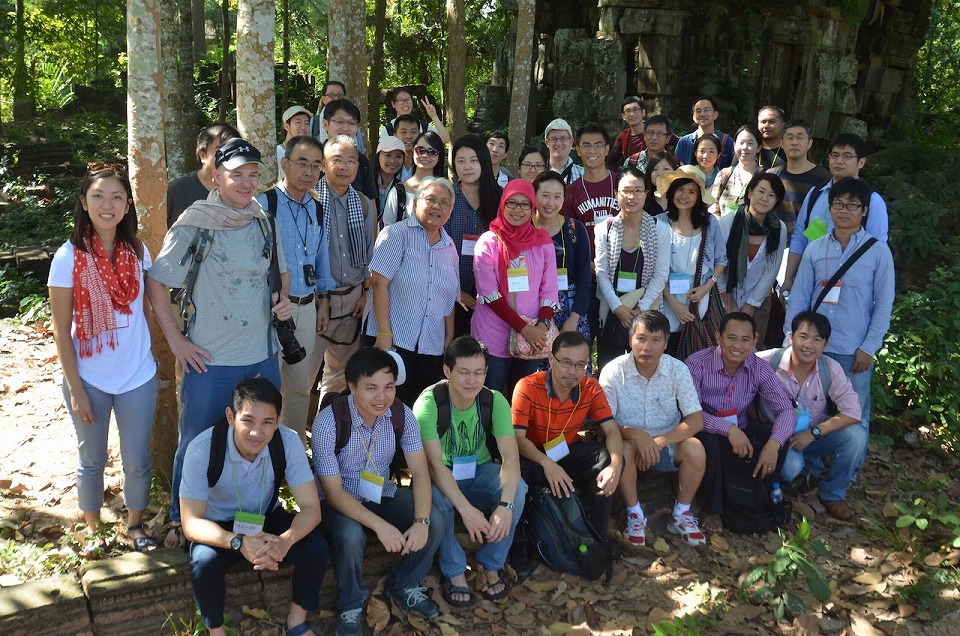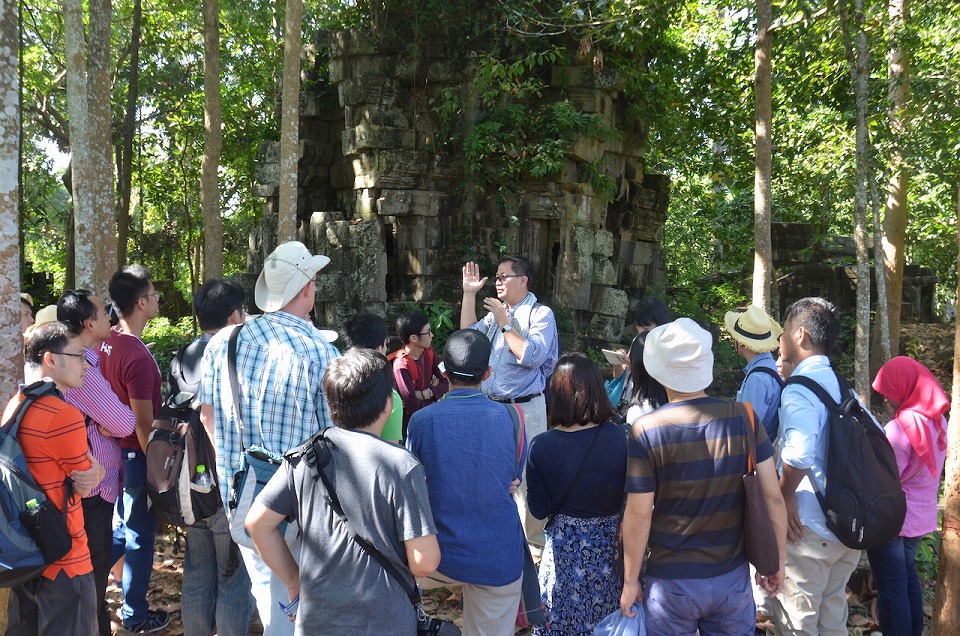
- このイベントは終了しました。
38th Southeast Asia Seminar: Connectivity in Southeast Asia: Multidisciplinary approaches to understanding global transformations
2014/11/22 @ 8:00 AM - 2014/11/25 @ 5:00 PM
Date: November 22-25, 2014
Venue: Siem Reap, Cambodia
Title: “Connectivity in Southeast Asia”
Program: » (10 Nov 2014 final)
The 38th Southeast Asia Seminar was held in Siem Reap, Cambodia from November 22 to 25, 2014.
23 participants from 11 countries and 17speakers and staff members from 6 countries gathered together in Siem Reap to discuss “connectivity.”
The seminar kicked off on November 22 with an opening talk with Dr. Kono Yasuyuki, Director of the Center for Southeast Asian Studies, who reminded the participants of the importance of thinking big. He suggested that we think of connectivity as a distinct “logic” of the human society or “humanosphere,” because humans have a unique ability to connect or disconnect with each other and to change the connections.
The seminar was designed in such a way that during the first half, the participants learned primarily through studies from Cambodia. We were blessed to have Professor Ang Choulean, the eminent historical anthropologist, as our keynote speaker. In his talk, Professor Ang Choulean showed the importance of historical thinking by showing artifacts and uncovering long-distance connections through them. He also pointed to lesser-known groups and places in the margins of national landscape, highlighting in particular a rich history of interaction between Siam and Khmer cultures.
This was followed, in the afternoon, by presentations made by five scholars of Cambodia. In his presentation archaeologist, Mr. Im Sokrithy (APSARA Authority) explained the extensive infrastructure network of the Angkor Empire. Speaking on the past and the present of the “East-West Cultural Corridors,” Prof. Shibayama Mamoru (Kyoto University) introduced a novel research method of informatics to illustrate how old networks could be visually mapped and assist our geographical understanding of region-wide connections. Dr. Hang Peou (APSARA Authority) illuminated the engineering knowledge and technology required by the construction and maintenance of the Angkor temples, highlighting a concern regarding the groundwater level today. Dr. Kobayashi Satoru (Kyoto University) and Dr. Hori Mina (Kochi University) then presented their research findings to illuminate contemporary forms of connectivity around Tonle Sap, analyzing the historical formation of regional society and the network of fishing industry respectably. Collectively, the set of presentations demonstrated that Siem Reap/Angkor/Tonle Sap proved to be a great entry point for us to think about various forms connectivity.
The following day was devoted to a fieldtrip around Tonle Sap. We first visited Domdaek, a rural area about 30 kilometers east of the town. And we learned about the Angkor-era infrastructure, especially transportation and public works, again from Mr. Im Sokrithy (APSARA Authority). We then visited Kampong Khleang, a community of the Tonle Sap Lake to deepen our understanding about livelihood changes and ecological linkages. Then we came back to the city of Siem Reap, a rapidly growing urban center to reflect the dramatic history of this region. The fieldtrip allowed the participants to gain knowledge about the Angkor Empire and its infrastructure networks, about Tonle Sap and its ecological and cultural connections, and about Siem Reap and its growing connections (and disconnections) through global tourism.
The fieldtrip was followed by three sessions (Session 3, 4, 5) on Day 3 and 4. Each session identified a particular theme, which was addressed in-depth by three presentations. First of the three sessions (Session 3), titled “Scale of connectivity: place, boundary, and distance,” explored the history and geography of Southeast Asia, addressing how we imagine “Southeast Asia.” Dr. Imamura Masao (Kyoto University) made a contrast between cosmopolitanism and vernacularism as two modes of connectivity. Dr. Oiyan Liu (The University of Hong Kong) investigated how “Southeast Asia” was imagined by certain Chinese intellectuals in the early 20th century. Dr. Dave Lumenta (University of Indonesia) analyzed the limits of the state-centric geography with a case study of Borneo. The session open a range of thought-provoking questions, and the participants exchanged views on how to think about nationalism to developmentalism on Southeast Asia.
Session 4 “Mobility and Connectivity: speed, direction, and intensity,” held in the afternoon of Day 3, addressed contemporary developments in Southeast Asia. Dr. Thanyathip Sripana (Chulalongkorn University) shed light on the rapid changes in mainland Southeast Asia, describing various corridors and cross-border openings. Dr. Yagura Kenjiro (Hannan University) scrutinized the implications of the long-term labor migration trends. Mr. Men Prachvuthy (Royal University of Phnom Penh) examined the dramatic increase of tourist industry in Siem Reap and profiled pro-poor policies. The presentations resulted in vibrant discussions on contemporary trends of urbanization and globalization—and their impacts.
Session5 “Connectivity and Communication: information, media, and vernacular” presented three studies, looking at various formation of media in Laos/Cambodia, Malaysia, and Indonesia. Dr. Iga Tsukasa (Kyoto University) demonstrated the development of online political media in Malaysia, suggesting a comparative framework applicable to other countries including Cambodia. Dr. Nathan Badenoch (Kyoto University) showed how minority language groups in Laos and Cambodia develop their own orthographies, dictionaries, and media and thereby make new linkages. Lastly, Dr. Carlotte Setijadi (Nanyang Technological University) presented a reflexive and historical analysis of “Chineseness” in the Indonesian mass media. Participants responded to the findings with comments on media politics, pop culture, and minority-majority relations.
The whole afternoon of Day 4 was dedicated to group activities. The entire participants was divided into four groups, and they received four different open-ended questions on connectivity:
- In the field and discussions, we have seen and talked about new and old types of connectivity across the region. Are the new types of connectivity fundamentally different from old types? Or are they actually quite similar? Do you see a significant break or gradual continuity? How is the difference/similarity between the old and the new viewed and understood by society?
- We are seeing strong developments of cross-border linkages across Southeast Asia. People, goods, money, information, and so on, are crossing the national borders much more easily today than before. Do you think these cross-border linkages are strengthening regional integration? Or do you think that their impacts are ultimately quite limited to the borderlands and that state territories are getting stronger than ever.
- As cities continue to expand and rural populations continue to migrate to urban areas, the urban-rural divide continues to widen. At the same time, many rural areas are arguably more connected precisely because of the movement of the people. In what ways is urban-rural connectivity changing? And is urban-connectivity the same as center-periphery connectivity? If not, how are they different? Finally, are there new forms of rural-rural connectivity?
- “Connectivity” has been mentioned as a key term for visioning the region’s future for some time. Is it, however, possible to consider the region in terms of disconnectivity? What are the emerging forms of disconnectivity in Southeast Asia. What would the region look like through disconnectivity as opposed to connectivity?
The groups spend two hours to make four creative posters. Each group made a ten-minute presentation in front of the rest of the participants—followed by a five-minute discussion period. The posters displayed both intelligence and creativity, and the presentations were followed by heated discussions (especially on the connectivity based on prahok, the Khmer food!).
The seminar was concluded by the remarks from the representatives from the two Cambodian organizations, APSARA Authority and the Royal University of Phnom Penh (Faculty of Development Studies).
Through the combination of presentations, discussions, group activities, and a field trip, the seminar provide a rare opportunity for researchers from both Southeast Asia and East Asia to meet and engage in in-depth discussions.


